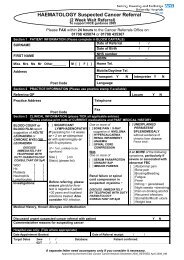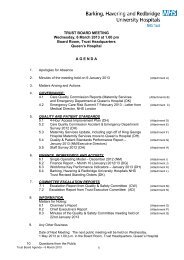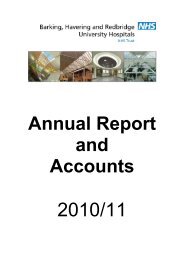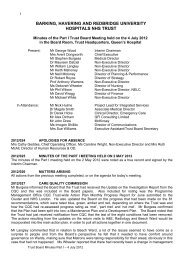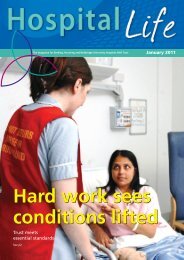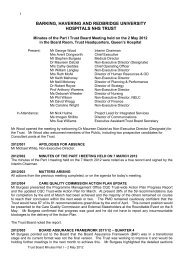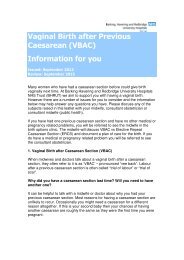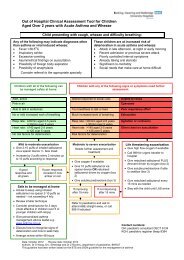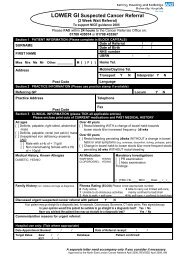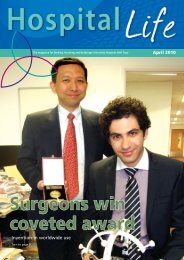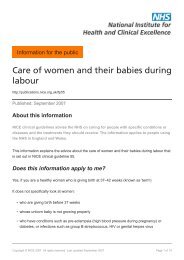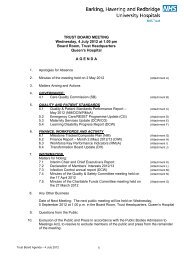Shoulder Hydrodilatation - Barking Havering and Redbridge ...
Shoulder Hydrodilatation - Barking Havering and Redbridge ...
Shoulder Hydrodilatation - Barking Havering and Redbridge ...
Create successful ePaper yourself
Turn your PDF publications into a flip-book with our unique Google optimized e-Paper software.
AFTER THE PROCEDURE:<br />
You should organize someone to accompany<br />
you home.<br />
Avoid heavy lifting including driving<br />
The shoulder may feel ‘squelchy’ for a day or<br />
so. After the local anaesthetic has worn off<br />
(about 4 hours), there may be an ache in the<br />
shoulder for the first night. It can be painful up<br />
to 3 days after the procedure.<br />
If you want any advice on this procedure, the<br />
numbers to call are listed on the back cover,<br />
for advice.<br />
This leaflet is a guide as to what is entailed<br />
in this examination <strong>and</strong> the possible risks<br />
<strong>and</strong> benefits of having this exam will be<br />
discussed by the radiologist taking your<br />
consent.<br />
Information from the British Society of Interventional<br />
Radiology (BSIR) <strong>and</strong> the Clinical<br />
Radiology Patients’ Liaison Group (CRPLG)<br />
of the Royal College of Radiologists has been<br />
used in this leaflet.<br />
<strong>Barking</strong>, <strong>Havering</strong> & <strong>Redbridge</strong><br />
University Hospitals NHS Trust<br />
The Radiology Department<br />
Queen’s Hospital<br />
Useful Telephone Numbers:<br />
X-Ray- 01708 435000 ext 3256<br />
Or 01708 435301<br />
(Monday to Friday 08.45 – 17.00 hrs)<br />
0845 130 4204<br />
(For use outside of the above hours)<br />
www.bhrhospitals.nhs.uk<br />
If you do not see or hear clearly <strong>and</strong><br />
require additional assistance, the Patient<br />
Advice <strong>and</strong> Liaison Service will be happy<br />
to help.<br />
PALS OFFICE<br />
24 hour answer phone<br />
0800 389 8324<br />
January 2012<br />
Revision date 2014<br />
DEPARTMENT OF<br />
INTERVENTIONAL RADIOLOGY<br />
SHOULDER<br />
HYDRODILATATION<br />
An information leaflet<br />
for patients <strong>and</strong> carers
What is<br />
HYDRODILATATION<br />
You have been<br />
referred for a<br />
hydrodilatation<br />
for an adhesive<br />
capsulitis also<br />
known as a<br />
‘frozen shoulder’.<br />
This is a simple<br />
procedure<br />
whereby the joint<br />
capsule is anaesthetized <strong>and</strong> stretched.<br />
PURPOSE<br />
The purpose of the treatment is to<br />
improve mobility of the shoulder joint<br />
<strong>and</strong> decrease pain in the shoulder.<br />
THE PROCEDURE<br />
You will be lying on an X-ray table.<br />
The radiologist (doctor) assisted by a<br />
radiographer will perform the<br />
treatment using X-ray as guidance.<br />
The skin is sterilized <strong>and</strong> anaesthetized.<br />
A fine needle is placed into the shoulder<br />
joint. Through this needle, a small<br />
amount of contrast medium (iodine or<br />
air), some local anaesthetic <strong>and</strong> steroid will be<br />
injected into the joint.<br />
Then up to 40ml of sterile saline will be injected<br />
through the same needle to stretch the joint capsule.<br />
This may cause a feeling of tightness, increased<br />
pressure or heaviness in the shoulder or down the<br />
arm. Some people may experience some pain <strong>and</strong><br />
should let staff know if this occurs. The procedure<br />
itself takes less than 10 minutes.<br />
RISKS AND PRECAUTIONS<br />
No procedure is without risk; however there are<br />
very few side effects to hydrodilatation.<br />
1. Allergy – some<br />
patients have a reaction<br />
to the Cortisone. This<br />
results in a red, itchy<br />
rash developing 1-2<br />
days after the procedure,<br />
<strong>and</strong> may last for<br />
up to a week <strong>and</strong> may<br />
be associated with a<br />
feeling of lethargy.<br />
If you are allergic to X-ray contrast (iodine),<br />
please inform the staff. The risk of getting an<br />
allergic reaction to the dye is 1/100000. This is<br />
slightly more common if you have other allergies<br />
2. Insulin-dependent diabetics may notice a<br />
moderate rise in blood sugar for up to 10<br />
days after the injection.<br />
3. Infection is a rare but potentially<br />
serious complication. The incidence<br />
of infection following steroid injection<br />
is in the order of 1/10000-<br />
20000. If you have any infected skin<br />
lesions such as a pimple in the<br />
shoulder region, the treatment will<br />
be postponed. If your shoulder feels<br />
hot <strong>and</strong> you are unwell with ‘flulike’<br />
symptoms one to four days after<br />
the procedure, please ring us or<br />
go <strong>and</strong> see your local doctor <strong>and</strong> tell<br />
that you had an injection into the<br />
joint.<br />
4. If, on the day of the procedure, you<br />
are unwell (particularly with a bad<br />
cold or ‘flu), please contact the department<br />
to postpone your appointment<br />
until you are well. This will<br />
decrease the risk of infection.<br />
5. Nursing mothers may prefer to delay<br />
the procedure until after they have<br />
finished breast feeding.



![[4] Biopsy Leaflet.pub - Barking, Havering and Redbridge University ...](https://img.yumpu.com/51285530/1/190x134/4-biopsy-leafletpub-barking-havering-and-redbridge-university-.jpg?quality=85)

